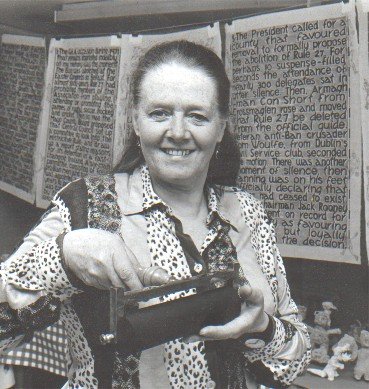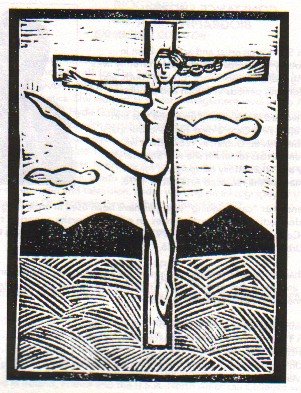 |
Short
Cuts [A review of Constance Short's exhibition, 'On Poems, Plays and Personal Things, Part 1', Poetry Society, London, 1993.] |
 |
Short
Cuts [A review of Constance Short's exhibition, 'On Poems, Plays and Personal Things, Part 1', Poetry Society, London, 1993.] |
| Having just returned from a
whirlwing promotional tour of 24 New England colleges on
behalf of the Burren College of Art, Dundalk-based artist
Constance Short is now in London for the opening of her
exhibition at the Poetry Society. Exhibiting first in 1967, she has intermittently, as she modestly states, taken "time off to have babies, save Ireland (and the world), and other worthwhile, and not so worthwhile, distractions". This description conceals real achievements: for example, the way in which time was managed to allow the mother of a young family to fulfil the dual functions of a parent and an artist, with time allotted to politics also. A founding member of the Irish Anti-Apartheid Movement, at a meeting of which we first met in the 1960s, she was also active in the Irish Labour Party. Latterly, she has demonstrated courage, initiative and imagination a Community Projects Manager and Cultural Advisor to Co-operation North; and as organiser of the conferences of the Cultures of Ireland Goup she has been a key figure in the attempt to extend debates on the diversity of Irish identities from Northern Ireland to the Republic. A member of a nationalist family from Crossmaglen, Co Armagh, her father, Con Short, is a past-president of the Ulster Council of the GAA (Gaelic Athletic Association) and author of the official history of the GAA in the province. It was he who successfully proposed the abolition of the ban on foreign games in 1972. Her uncle Frank - father of Clare Short MP, who opened the exhibition - was a founder and leading member of the Anti-Partition League in Britain. Constance herself was once told that she had "a schizophrenic need to be both painter and politician". Working initially in oils, she returned to art as the mother of three young children: linocuts at the kitchen table, then a course in etching with John Kelly at the Dublin Graphic Studio, followed by regular sessions at the studio during mornings when the children were at school. She began to exhibit again in the mid-1970s. The subject of an etching of this period, 'Emmet tar éis lóin', was the son of a similarly child-bound neighbour with whom she used to exchange visits, sketching in the neighbour's kitchen. Between times, in addition to raising her family, she has worked on many schemes connected with the arts, all of which benefitted from her formidable abilities as a networker and an enthuser of others. This included stints in numerous schools under the Irish Arts Council's 'Paint on the Wall' scheme, during which she completed some 40 murals. Short speaks with enthusiasm of the two mediums between which she currently alternates - the linocut and the monotype - describing how the freedom of the latter offers a relief from the discipline and attention to detail required by the former. In her cover for Nuala Ní Dhomhnaill's Pharaoh's Daughter (1990) - a monotype illustrating the poem 'Fear/Looking at a Man' - the rich and yet economical brushlines are appropriate to the subject. This illustration is related to a series of monotypes and linocuts on the theme of the model as voyeur - where the nude model, comfortably seated in an academic pose, boldly eyes-up the naked male, or males. The starkness of some of the linocuts in the present exhibition echoes Constance's drawings accompanying Eavan Boland's poems, In Her Own Image (1980). The illustration to 'Anorexic', for example, is a stark visual representation of the subject of the poem which opens with the lines: Flesh is heretic, The expressionist nature of her work is underlined by her present exhibition. An admirer of the work of Francis Bacon, Short accepts the possibility of his influence in the spatial organisation of some of her pictures. However, her present work has a buoyancy which can be seen, for example, the the composition of the daughters in 'Image From the House of Bernarda Alba, Lorca' or in 'Image From Three Sisters, Chekov', which translates into strength as they are overlooked or surrounded by the forces of tradition which impinge upon them. Speaking of 'Let the Dark Shine Through', Short tells how she uses the basic features of her medium to juxtapose the rough outlines of an existing reality and the elegant incised lines which define the dark, enthroned areas of potentiality. One of my own favourites from this exhibition is 'Dance, Dance, Dance', where seven shaven-headed, leotard-clad females dance in line, arms entwined, absorbed in the activity of the dance - an image at once of independence and solidarity. The exhibition opens with an introduction: a double self-portrait, the artist and her alter ego. The lino cuts are hung in the order in which they were produced, telling a story and reflecting changing moods over the period. Overall, the series "is trying to make a statement about the marginalised in society, taking the situation of women as the symbol for all". Undoubtedly, it contains a multitude of strong, arresting, and fluently-executed visual statements. |
 |
 |
Published in The Irish Post, 11 December 1993.
| Two
images from Constance's New York exhibition (1996) of
lino-cut prints on rice paper, 'Jumpin' the Border', held
at the SOHO20 Gallery: 'Dancing at the Crossroads',
6" x 8", 'Sammy/Seamus na Gig', 8" x
8". [The 'sheela-na-gig' was a carved female figure standing or sitting so as to display the genitals, originating as a symbolic representation of lust - extant carvings date from the 13th to 17th centuries. There is a play in the title of this work on the stereotypically Protestant and Catholic first names, Sammy and Seamus.] |
 |
 |
| The following are
extracts from the 'Artist's Statement' for that
exhibition: 'Jumpin' The Border' is the expression used along the border between Northen Ireland and the Republic of Ireland to describe illegal crossings. In my childhood it involved the use of unapproved roads to smuggle food and goods. In more recent times it has meant a lot more. With the peace process going on 'Jumpin' The Border' can take on further meaning; the courage to move from fixed positions. In my artwork, I try to explore imaginative ways forward through the use of the body. My favourite quotation is "If I can't dance, I don't want to be part of your revolution," by Emma Goldman. I use "dance" as a metaphor for freedom, choice and celebration, and "sleep" as a symbol of lack of power, helplessness, and intransigence.... |